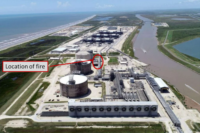Freeport LNG says it expects to restart part of its liquefied natural gas export plant on time later this month as Kiewit Corp. completes final repair and restoration after a June 8 explosion and fire closed the 2.38-billion cu ft-per-day facility, a major U.S. site for LNG shipments to Europe.
But the gas supplier declined to comment on a new Texas fire marshal investigative report on the incident or on the status and scope of Kiewit's work.
The three-train, 15-million-ton-per-year plant south of Galveston is the second largest in the U.S. and produces about 4% of global capacity. It began operating as an import terminal in 2008 and began exporting in 2019.
“We continue to progress our work toward achieving the November restart of our liquefaction facility,” said Freeport LNG spokesperson Heather Browne in an email. “That work includes completing final repair and restoration efforts, [and] required work plans and obtaining the necessary regulatory approvals.”
Inspectors found a blocked relief valve with a “high probability” that it created the events that caused the accident at the plant, said Karl Gingrich, deputy Brazoria County fire marshal, in his report after noting discussions in mid-June with an inspector for IFO Group, a firm hired by Freeport LNG to lead the investigation. The blocked relief valve possibly caused a “low order” overpressure in an 18-in. recirculation line, he said.
The fire marshal’s report was obtained by E&E News through a request under the Texas Public Information Act. The news site also obtained recordings between the consultant and fire marshal office investigators. “The managers did not halt operations because they did not want to acknowledge there was a problem in the plant,” E&E quoted an IFO Group executive as saying. “It was hubris,” he said.
The relief valve was not opened after maintenance was completed in early spring, Gingrich said, noting there was no evidence of malicious behavior, only human error.
The process valve became blocked about four days before the explosion, which allowed the “process in the pipe to cook and heat up until the pipe was no longer able to contain the pressure,” he said. Without the pressure safety valve there was no outlet.
The first indication of a problem was four or five days before the explosion when a pipe fell off the pipe rack.
“Expansion joints that are in place are designed to allow for movement of the pipes due to thermal expansion and based on the amount of damage the pipes appear to have been moving more than what the expansion joints are designed to allow,” the fire marshal’s report said.
Two days before the explosion Freeport LNG investigated the movement of pipes, but it was written off “to a bad pipe hanger,” the report said. An engineering firm. whose identity was not disclosed, was hired to evaluate the pipe racks the day before the explosion, but no action was taken before the explosion, according to the Gingrich. “Engineering design of the pipe rack performed as it was designed to do,” he said.
Gingrich noted that the inspector and his team found relatively small damage around the pipe, which indicated a low order explosion. “No windows or doors were damaged, some light fixtures sustained minor damage,” he said. The LNG remained in the trench and the fire was contained in the area until the fuel burned away extinguishing the fire, Gingrich said.
Freeport LNG did not comment on the report and an attorney at King & Spalding, which represents the firm, said the information was private until the investigation is complete.
Kiewit has the EPC contract to repair the plant, which includes corrective measures included in a consent agreement with the pipeline agency. Freeport LNG said it expects to have the plant able to produce up to 2 billion cu ft per day by the end of the month and at its full capacity of 2.38 billion cu ft per day by March.
Freeport LNG said it is coordinating closely with the pipeline safety agency, the Federal Energy Regulatory Commission and others, including the U.S. Coast Guard, which earlier issued an order that restricts all marine cargo operations until Freeport conducts a risk analysis on marine transfers.
The plant must receive written authorization before restarting any non-emergency operations, FERC said Oct. 26. The commission, the company and the pipeline safety agency discussed current activities at the site including damage assessment, repairs and plans for restart on Oct. 20, FERC said.
Freeport LNG also plans to add a fourth 5-million-ton-per-year train, but in May asked FERC to extend the completion deadline until August 2028 from the current 2026 date to accommodate supply chain disruptions.






Post a comment to this article
Report Abusive Comment